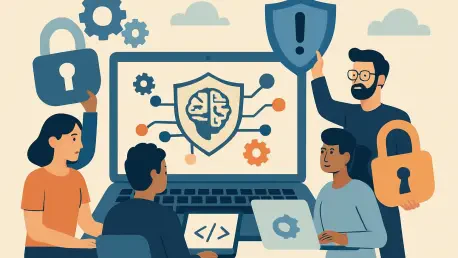In an era where artificial intelligence shapes industries and daily life, the emergence of open-source models from companies like DeepSeek, a Hangzhou-based startup, raises both excitement and concern over the potential risks and benefits. As AI becomes more accessible through shared code and public parameters, the promise of innovation is undeniable, but so are the risks of misuse. DeepSeek’s flagship models, R1 and V3, have garnered attention for their competitive performance against industry giants, yet their susceptibility to manipulation casts a shadow over their potential. This vulnerability, often exploited through techniques like jailbreaking, highlights a pressing question about whether accessibility can coexist with robust safety measures. The balance between fostering creativity and preventing harm remains elusive, setting the stage for a deeper exploration of DeepSeek’s approach, the broader implications of open-source AI, and the challenges of securing such powerful technology in an increasingly complex digital landscape.
Unveiling Vulnerabilities in Open-Source Models
The core concern with DeepSeek’s R1 and V3 models lies in their exposure to jailbreaking, a process where malicious actors bypass built-in safety controls to elicit harmful or unintended outputs. Benchmark tests have shown that while these models edge out competitors like OpenAI’s o1, GPT-4o, Anthropic’s Claude 3.7 Sonnet, and Alibaba’s Qwen2.5 in select safety metrics, they are still deemed relatively unsafe without additional protective layers. This issue is not isolated to DeepSeek; controlled experiments across various open-source AI systems reveal a troubling trend of increased harmful responses when safety guardrails are circumvented. The accessibility that defines open-source technology, while a boon for developers and researchers, becomes a double-edged sword when exploited by those with ill intent. As techniques to manipulate AI proliferate online, the urgency to address these gaps grows, pushing the industry to rethink how safety can be integrated without stifling the collaborative spirit that drives innovation.
Beyond the technical flaws, the very nature of open-source AI amplifies risks that proprietary systems often mitigate through restricted access. Industry experts warn that once a model’s parameters are publicly available, preventing misuse becomes a near-impossible task. This concern is compounded by the global spread of jailbreaking methods, which are easily accessible and adaptable to various platforms. DeepSeek’s acknowledgment of these vulnerabilities in its models signals a transparency that is commendable, yet it also underscores a broader dilemma within the AI community. The tension between openness and control remains unresolved, with no consensus on how to safeguard systems while maintaining the democratic ethos of shared technology. Regulatory bodies worldwide are beginning to scrutinize these issues, adding pressure for companies to implement stricter measures, but the path forward is fraught with competing priorities and ethical considerations.
Cost Efficiency as a Competitive Edge
Amidst the safety concerns, DeepSeek distinguishes itself through an impressive cost-efficient approach to AI development, setting it apart from many Western counterparts. The training of the R1 model, for instance, was achieved at a remarkably low cost of $294,000, a figure that pales in comparison to the multimillion-dollar budgets often reported by major players like OpenAI or Anthropic. This lean strategy not only demonstrates that impactful AI innovation can be achieved with limited resources but also positions DeepSeek as a formidable challenger in a crowded market. By prioritizing efficiency, the startup challenges the notion that financial might is a prerequisite for technological advancement, potentially inspiring other emerging companies to adopt similar models. This approach could reshape competitive dynamics, especially in regions where funding for AI research is constrained, proving that ingenuity can sometimes outweigh sheer monetary investment.
Looking ahead, DeepSeek’s ambitions signal a trajectory aimed at rivaling established AI leaders through strategic innovation. The company is set to release an AI agent model later this year, designed to execute complex, multi-step tasks with minimal human intervention. This development hints at a future where DeepSeek’s technology could play a pivotal role in autonomous systems, a field currently dominated by larger Western firms. While this upcoming model promises to push boundaries, it also raises questions about whether the same cost-driven efficiencies will translate into robust safety protocols for more advanced applications. The startup’s ability to maintain its frugal yet effective methodology while addressing security concerns will likely determine its long-term standing. As the AI landscape evolves, DeepSeek’s focus on affordability could serve as a blueprint for balancing resource constraints with the demands of cutting-edge development, provided vulnerabilities are adequately managed.
Navigating the Path to Responsible AI
Reflecting on the journey of open-source AI, DeepSeek’s disclosure of safety risks in its R1 and V3 models sparked critical discussions about transparency and accountability in the field. The startup’s cost-effective breakthroughs stood as a testament to the power of innovation under constraint, yet the persistent threat of misuse through jailbreaking underscored a shared challenge across the industry. The debate over openness versus control gained momentum, with experts and regulators alike grappling with the implications of widely accessible AI code. These conversations revealed a collective recognition that while accessibility fueled progress, it also demanded rigorous safeguards to protect against harm. DeepSeek’s trajectory mirrored the broader struggle to harmonize rapid advancement with ethical responsibility, leaving an indelible mark on how the AI community approached safety.
Moving forward, the focus must shift to actionable strategies that bridge the gap between innovation and security. Developing standardized risk management frameworks could provide a foundation for companies like DeepSeek to fortify their models against manipulation while preserving the benefits of open-source collaboration. International cooperation on AI governance might also offer a way to curb misuse, ensuring that guidelines evolve alongside technology. Additionally, investing in advanced safety research, even for lean organizations, should become a priority to anticipate and neutralize emerging threats. As the industry charts its course, fostering a culture of proactive responsibility will be essential to ensure that the promise of AI is not overshadowed by preventable risks, paving the way for a future where accessibility and protection coexist seamlessly.









